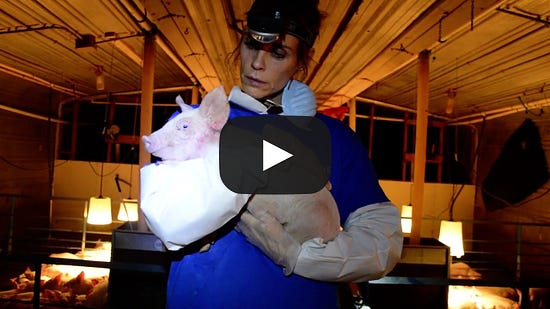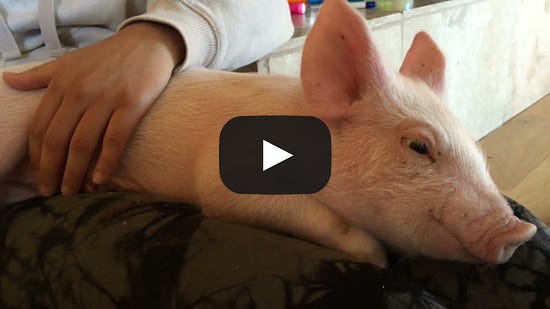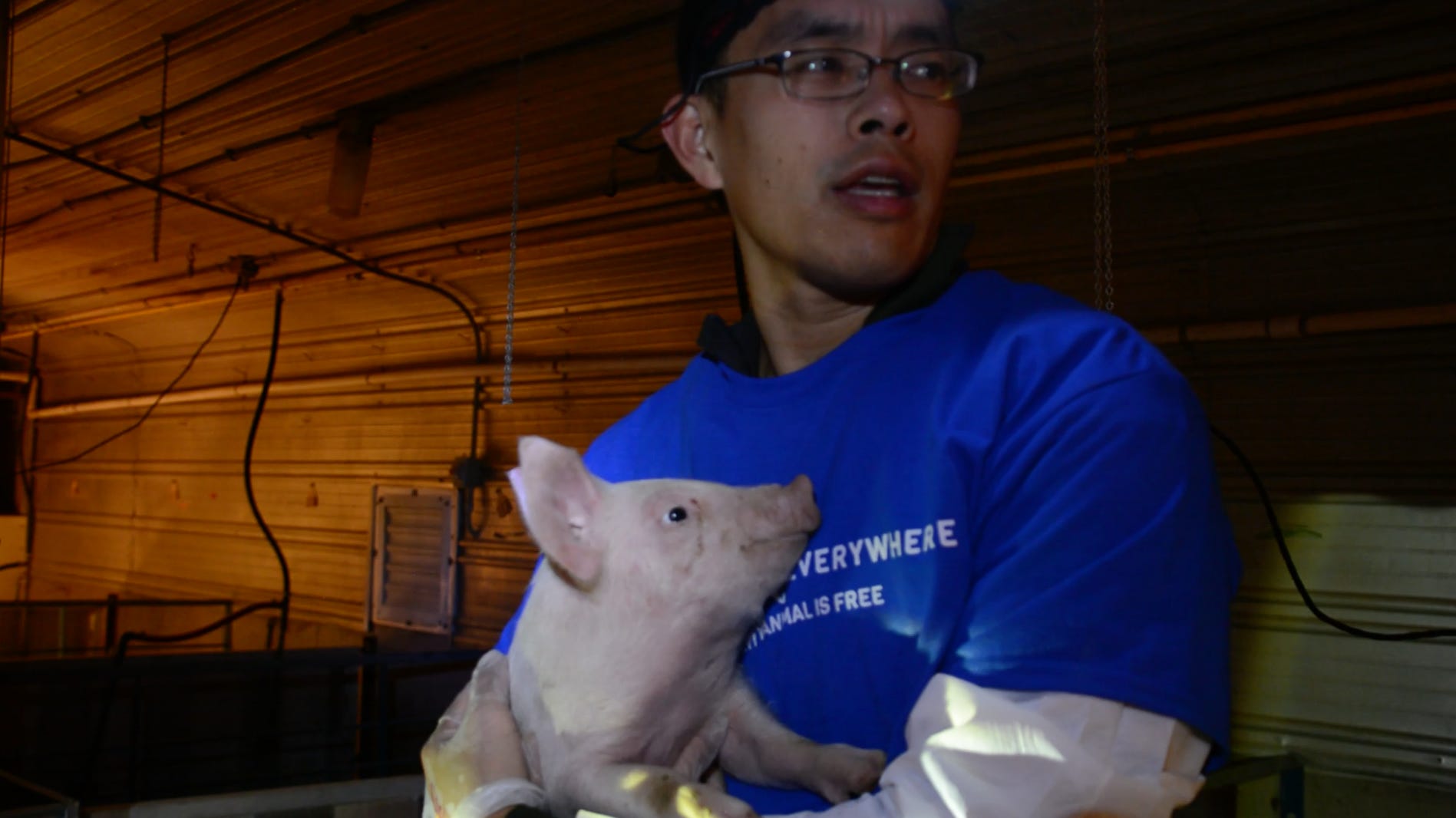What I learned from saving Chester – then watching him die
A failed rescue brought important lessons: on shame, and on fighting the good fight. (Part II)
I wrote last week about the disturbing cruelty with which our food system treats the most vulnerable beings: the sick, the weak, and (especially) the young. One of my first experiences inside a Smithfield pig factory farm was a window into that cruelty, as I witnessed a starving baby pig, trapped in the gaps of her metal pen, and made the heartbreaking decision to leave her behind.
My subconscious punished me for that decision for many weeks, as I woke up many times screaming and pulling at my hair. Images of the little pig starving on the floor of the factory farm flashed through my mind.
But the failure to save her came with a silver lining. For one, I learned something about the system I was trying to confront. As I wrote in my prior post:
The basic problem was this. Farmer John, perhaps due to Prop 2, had shut down its entire breeding operation in California and was now shipping in piglets to raise at the farm, perhaps from distances as far away as Southern Utah. While this might have insulated the company from legal liability, as it could no longer be held accountable for confining mother pigs in so-called gestation crates, it also meant that the piglets were going through a potentially hazardous, long-distance journey, at just 2-3 weeks of age, in scathing heat, and without their mother (or their mothers’ life-saving milk) to protect them. And the result was a system filled with sickness, starvation, and death.
Even if I was not able to save that piglet, this lesson — that regulation can have unintended consequences, especially when the system is corrupt — became a central part of my advocacy over the next 4 years, and even played a small role in the successful campaign to amend Prop 2 to give it enforcement teeth. (Our work pointing out the failures of Prop 2 provided some of the motivation for it to be changed.)
But there was another crucial lesson from my failure to save that baby pig, that became apparent in the weeks to come. Shame can be fuel for change, if we don’t allow it to eat away our motivation to act.
After waking up from a night terror, I would go into a storage shed where I could meditate in complete darkness. I would sit there, silently, and observe my feelings, as if I were watching the story of my life from an immaterial plane above. I didn’t run from these feelings, or pretend they didn’t exist. I looked at them, imagined myself touching them as fi they were material things, and even learned to share them with others, openly. (I’ve speculated previously that this sort of openness might be the cure for shame.)
Every time I’ve told the story of the piglet I left behind — privately, for many years; and now publicly for the first time — it has taken a little bit of the edge off the pain. And with time, the shame was transformed into fuel for action. This is the key distinction between the positive and negative forms of shame: positive shame activates, while the negative shame depresses.
Today, I can watch the video of what happened, and cry the same tears I cried in 2016. But the paralyzing feeling I once felt is now replaced by an active force: the desire to help another baby pig.
And that is precisely what we did.
A Life on Metal and Concrete
We took a few weeks after the experience with the starving piglet to pause our work. I and the other team members needed time to recover from what we had seen and ensure that, next time, we would be prepared to provide emergency medical care.
Our preparations were immediately put to the test.
I didn’t notice Chester at first. He looked like a piglet who was simply asleep. But then I saw a piglet step right on Chester’s face; he failed to even respond. Something was wrong. I am publishing the video of what we observed for the first time today.

Chester’s entire life, at a mere one month of age, was harshness. Below him was the strain of metal and concrete. He had never known the feeling of anything soft. Above him was a rain of hooves and limbs and bodies. The normal love from a mother’s touch from above was replaced by a mob descending on him violently in the search for food. (The piglets in this video are biting and trampling him because they are prematurely taken from their mothers, often in less than 17 days. They are desperate to find somewhere to nurse.)
From above and below, Chester knew only pain. You could not fault an animal in such a state for giving up. And, indeed, when we found him, it seemed he was at his breaking point.
But Chester fought to live, in the weeks, days, and hours before we found him. And because of that, he would not die on this day. Unlike our prior visit, we had emergency medical gear available, including towels to carry a piglet through the cold; a crate to transport him; and warm baby formula to nourish and hydrate him.
I worked with two of our team members, legendary animal rights activist Chris DeRose, the founder of Last Chance for Animals, and actor/activist Alexandra Paul, to gently remove him from the pen. And while he was obviously still struggling, we saw immediately that he seemed relieved to be freed from his cage. His eyes lit up, and his head began moving with alertness, from the moment I placed him in Alexandra’s arms.

The next few weeks with Chester were as magical, as his first month was a nightmare. He slept in a bed with two other piglets we rescued, as all 3 recovered from deadly injuries and disease. He went outside for the first time, and seemed stunned by the beauty of the sun and the healing smell of the soft soil. And, perhaps most important, he learned that the world did not have to be a harsh place.
After living only on metal and concrete, Chester was obsessed with finding soft places to lie. And one of the softest places for any baby animal is on their mother’s body. Chester found something nearly as good: our laps, as a place to sleep and be safe. So every chance he would get, he would crawl onto our laps and beg us for a belly rub. He cherished the feeling of our soft warmth below him. And he felt our love from above, as we scratched his chin or gave him a belly rub.

But Chester’s ending was not a happy one. The toll of the pathogens and stress and denial of maternal care was too much for this little pig. When he continued to show signs of weakness, and failed to put on weight, we took him to an academic veterinary hospital for treatment. They came back with a devastating diagnosis. Chester had a cardiac condition. There was too much pressure in the right ventricle of his heart, perhaps due to the disease and strain at the farm. And at any moment, his little heart could burst.
We were hopeful that it would happen months, if not years, later. But sadly, about two weeks after the diagnosis, I woke to Chester’s screaming in the middle of the night. I rushed into Chester’s room and saw him thrashing on the floor. I screamed and tried to take him into my arms. There was a desperate look in his face, as if saying, “No, please, not now! My life has just become so happy and safe!” But despite Chester’s fight, his heart simply couldn’t take it. We watched as the thrashing stopped, and he collapsed on the floor.
Chester was dead.
Lessons from Two Little Pigs
There are hard lessons from Chester’s life and death. I have asked myself, many times, if we should have saved another pig. From the moment I saw him, Chester’s condition was bad, and deteriorating. And the spot we reserved for Chester on the night of that rescue could have gone to another piglet, one who might still be alive today.
But “right” answers, in a system filled with such overwhelming cruelty, are hard to find. And I cannot regret saving Chester, even if he only received another three weeks of life. Those three weeks, I am sure, meant everything to him. They were only taste of the freedom. His only experience with a real life..
What I ultimately learned from the choice to save Chester, though, is that whatever decision we make in such instances, it must be educated and informed. With Chester’s rescue, I tried to prepare our team members for the possibility that one of our rescues would die. But my preparations were limited and abstract. When we saw Chester declining, I did not know the how and the why.
Chester’s death, for example, was one of my first experiences with the death throes, the desperate flailing that occurs in many animals before their moment of death. Previously, I had assumed that the concept was purely metaphorical. Chester showed me that it is, in fact, very real.
Since that day, I’ve tried my best to educate myself more fully in the conditions we are likely to see in factory farms; the prospects for an animal to survive; and the necessary care for giving them the best chance at life. Chester’s death gave me the motivation for that.
But the other important lesson from Chester’s death is that, even when we fail, there is beauty in the fight. Chester’s life from birth was a struggle for existence. Taken from his mother at a too-early age; forced to fight for food and space in a steel and concrete pen; and struggling through it all with a tiny broken heart. At any point, Chester could have given up. It was, perhaps, the reasonable thing to do; liberation was an impossible dream. But he never did. And because of that, he realized the beauty and love and meaning that so few animals in factory farms ever realize. He realized, even for a few brief weeks, what it means to be loved, and to be free.
I think his last moments in the death throes were an indication of how much this meant to him. He knew what he was losing, and how much it meant to him after a lifetime of darkness and pain. And he was not willing to lose it — to lose love and freedom — without a fight.
—
The world is in a difficult place. I wrote last week about the deaths of despair that are skyrocketing, a pandemic of disconnection that is killing millions across the globe. But another way to think about these deaths is not through despair, but resignation. The world is so tough and unfair that’s easier to give up — lose ourselves in drugs or isolation or dystopian digital worlds — than to fight through the reality of the world in which we live.
But the most important lesson from the two pigs I met at Smithfield, in the winter of 2016, is that our world is worth fighting for. If a piglet trapped in the metal grates, and another suffering from a broken heart, can keep fighting, then surely so can you and I.
It’s a lesson I will need to take to heart, as I face what will likely be my most dangerous trial this September, for investigating and saving dying piglets — not so different from Chester — from Smithfield Foods. But it’s a lesson that all of us can apply to the personal trials that we face, legal or otherwise. When you’re facing something hard, think of Chester, and of how much he was willing to fight.
I like to think that Chester, in seeing the fight in all of us, would smile and tell us he’s proud. I’ll think of him in Utah as I face the prospect of a 10+ years in prison. And I have no doubt that, no matter what happens in that courtroom, Chester’s memory — his willingness to fight the good fight, even when the odds were stacked against him — will bring a smile to my face.
Read Part I of this series here.
If you liked this post from The Simple Heart, why not share it?
